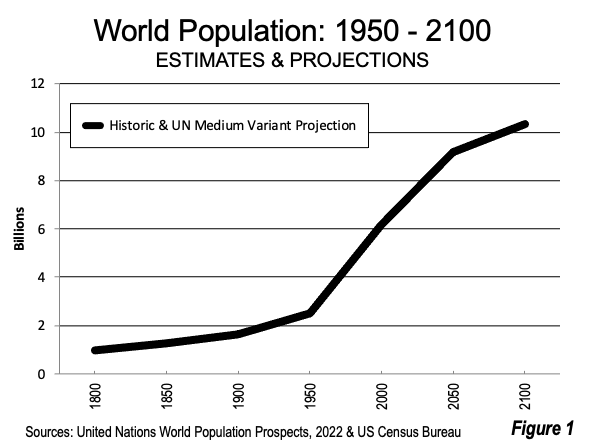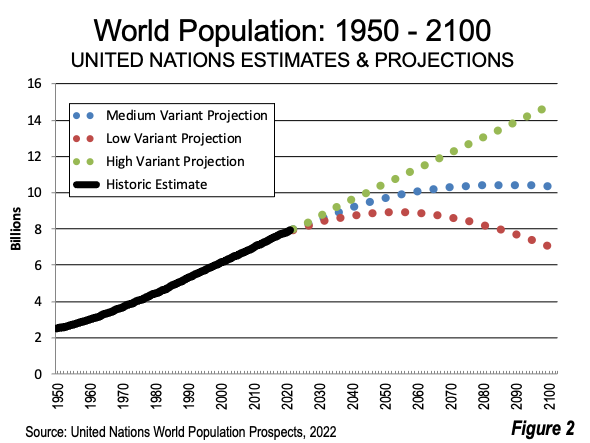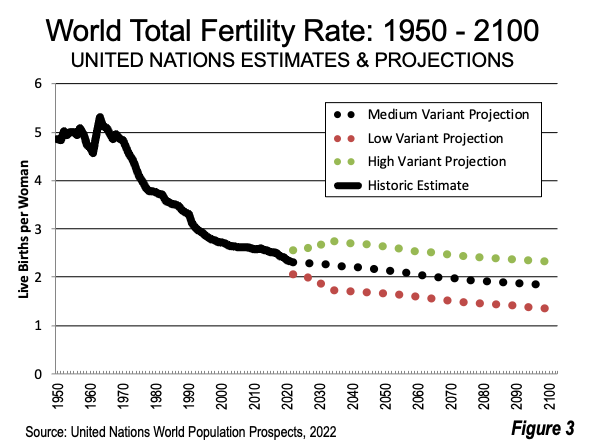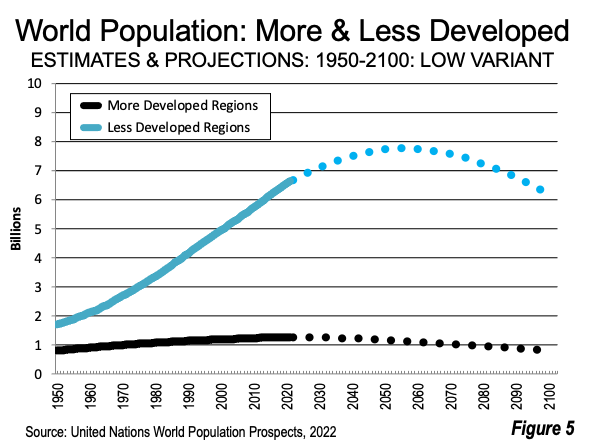Since the beginning of the 19th century, world population has skyrocketed. According to a summary of estimates by the US Census Bureau, the world population was about 970 million in 1800 (midpoint of the high and low estimate). The Census Bureau site indicates that population usually increased in previous centuries, though was at an all-time high in 1800.
During the 19th century, world population is estimated to have increased about 70 percent, to nearly 1.7 billion. During the 20th century, world population increased 4.5 billion, to 6.5 billion residents, an increase of more than 270%. Current United Nations projections anticipate 21st century growth to be 4.2 billion, reaching 10.4 billion, a nearly 70 percent increase. Under the United Nations low variant projection, the population would rise 900 million, to a total of 7.0 billion, a 15 percent increase (Figure 1).

The acceleration of growth after 1800 was based on various factors, all of which have been facilitated by the unprecedented economic growth since that time. Medical advances have led to substantial reductions in infant mortality and greater longevity. There has been unprecedented urbanization since 1800, when only 5% of the population was urban; the share of urban population has now reached above 55 percent.
At the same time, fertility rates (the number of live births by the average woman of childbearing years) have dropped significantly in recent decades, at the same time that standards of living have increased. Economists have identified an association between lower fertility rates and greater affluence.
From Now to 2100
Now, the world population is nearly 7.9 billion, according to the United Nations World Population Prospects 2022. This is more than three times the 1950 population (2.5 billion), the earliest year for which UN population data are available. The population is expected to exceed eight billion before the end of 2022 (See: Note: UN Population Projection Accuracy).
World Population Prospects 2022, provides three population projection scenarios to 2100. The “median variant” projections receive the most attention, but there are also the “low variant” and “high variant” projections (Figure 2).

Under the median variant, the 21st century could add another four billion, with a rise to 10.349 billion in 2100, but by this time the planet’s population would be declining. The world population is projected to peak at 10.431 billion in 2086. In the last year (2099-2100), the population would decline 11 million, equal to the population of North Carolina.
Under the low variant, the world population would drop to 7.043 billion in 2100, which is about one third (32 percent) lower than the medium variant projection. In one year between 2099 and 2100, the world population would drop about 65 million, about the population of France. The peak population would be reached in 2053, at 8.939 billion, 33 years before the medium variant. From 2022 to 2100, the population is projected to drop by 1.9 billion.
The high variant presents a far different picture. By 2100, the world population would rise to 14.8 billion, an increase of about 85 percent. Population would not have reached its peak by that time, as from 2099 to 2100, the population would rise nearly 90 million, equal to today’s population of Iran.
Total Fertility Rate
Obviously, fertility is a principal driver of population growth, along with longer lives. In 1950, the world total fertility rate (TFR), was 4.9. A TFR of about 2.1 is required to maintain the level of population. However, from 1950 to 2022, there was a substantial decline in the TFR, to 2.3, only marginally above the replacement rate. Projections call for the TFRs in all three variants to continue their decline, which is why population peaks in the 2080s under the median variant and in the 2050s under the low variant. In 2100, the medium variant estimates the world TFR to be a below-replacement level of 1.84, with a 1.36 TFR under the low variant. Under the high variant, the TFR would remain above replacement rate, at 2.32 (Figure 3).

More and Less Developed Regions
Population increases in the highest income countries long have been far lower than in the rest of the world. The United Nations classifies Northern America (Canada, the United States, and some Caribbean nations), Europe, Japan, Australia and New Zealand as “more developed regions.” The rest of the world is considered “less developed regions.” In 1950, the more developed regions had a population of about 800 million. The less developed regions had 1.7 billion, accounting for more than two-thirds of the world’s population.
In the next 70 years, (to 2022), the population of the more developed regions increased 500 million, to nearly 1.3 billion. At the same time, the less developed regions experienced a population explosion nearly 10 times larger, adding nearly 5 million to reach 6.7 billion. Over the past seven decades about 90 percent of population growth has been outside the more developed regions.
Medium Variant Projections: From now to 2100, the more developed regions would lose nearly 125 million residents under the medium variant projection. The more developed nations would fall from 1.275 billion to 1.15 million in 2100. This loss is about the present population of Japan. All of the population growth would be in the less developed regions, at 2.5 billion, with a population increase from 6.7 billion to 9.2 billion (Figure 4).

Low Variant Projections: Under the low variant projection, the more developed regions would lose 470 million, from the present 1.275 billion to 800 million. This one-third loss is equal to the present population of the United States (330 million) and the Russian Federation (145 million). At the same time, the less developed regions would experience nearly as great a loss, at 430 million, dropping to from 6.7 billion in 2022 to 6.2 billion in 2100 (Figure 5).

With the declining total fertility rates, it appears likely that the world population will reach a peak by the end of this century, as the United Nations projects, or perhaps considerably earlier. Already populations have stabilized or are declining in nations such as Japan. South Korea and China and will soon be losing population. The future demographic growth will be driven by TFRs in the less developed world, especially in sub-Saharan Africa, where rates remain high. Critically they also could follow the pattern seen in some of the poorest nations in the world have fallen to replacement rate or below, including India and Bangladesh. The future is far from settled, but it seems the once terrifying population tsunami may soon be replaced by less extreme waves.
Note on UN Population Projections: A quick review of the UN’s World Population Prospects: 1980, indicates considerable accuracy with respect to the world population in 2020. In 1980, the UN projected world population to be between 7.376 (low variant) and 8.063 billion (medium variant) in 2020. In 2022, the UN estimated the world population at 7.894 billion, which is about 2.5 percent below projection. The 2020 population was about three quarters of the way between the low and medium variants as projected in 1980.
Wendell Cox is principal of Demographia, an international public policy firm located in the St. Louis metropolitan area. He is a founding senior fellow at the Urban Reform Institute, Houston, a Senior Fellow with the Frontier Centre for Public Policy in Winnipeg and a member of the Advisory Board of the Center for Demographics and Policy at Chapman University in Orange, California. He has served as a visiting professor at the Conservatoire National des Arts et Metiers in Paris. His principal interests are economics, poverty alleviation, demographics, urban policy and transport. He is co-author of the annual Demographia International Housing Affordability Survey and author of Demographia World Urban Areas.
Mayor Tom Bradley appointed him to three terms on the Los Angeles County Transportation Commission (1977-1985) and Speaker of the House Newt Gingrich appointed him to the Amtrak Reform Council, to complete the unexpired term of New Jersey Governor Christine Todd Whitman (1999-2002). He is author of War on the Dream: How Anti-Sprawl Policy Threatens the Quality of Life and Toward More Prosperous Cities: A Framing Essay on Urban Areas, Transport, Planning and the Dimensions of Sustainability.
Photo: Dhaka, Bangladesh (by author)












